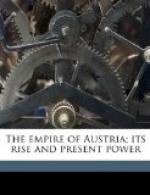Rhodolph, encouraged by success, pressed his measure of intolerance with renovated vigor. Having quite effectually abolished the Protestant worship in the States of Austria, he turned his attention to Bohemia, where, under the mild government of his father, the Protestants had enjoyed a degree of liberty of conscience hardly known in any other part of Europe. The realm was startled by the promulgation of a decree forbidding both Calvinists and Lutherans from holding any meetings for divine worship, and declaring them incapacitated from holding any official employment whatever. At the same time he abolished all their schools, and either closed all their churches, or placed in them Catholic preachers. These same decrees were also promulgated and these same measures adopted in Hungary. And still the Protestants, insanely quarreling among themselves upon the most abstruse points of theological philosophy, chose rather to be devoured piecemeal by their great enemy than to combine in self-defense.
The emperor now turned from his own dominions of Austria, Hungary and Bohemia, where he reigned in undisputed sway, to other States of the empire, which were governed by their own independent rulers and laws, and where the power of the emperor was shadowy and limited. He began with the city of Aix-la-Chapelle, in a Prussian province on the Lower Rhine; sent an army there, took possession of the town, expelled the Protestants from the magistracy, driving some of them into exile, inflicting heavy fines upon others, and abolishing entirely the exercise of the Protestant religion.
He then turned to Donauworth, an important city of Bavaria, upon the Upper Danube. This was a Protestant city, having within its walls but few Catholics. There was in the city one Catholic religious establishment, a Benedictine abbey. The friars enjoyed unlimited freedom of conscience and worship within their own walls, but were not permitted to occupy the streets with their processions, performing the forms and ceremonies of the Catholic church. The Catholics, encouraged by the emperor, sent out a procession from the walls of the abbey, with torches, banners, relics and all the pageants of Catholic worship. The magistrates stopped the procession, took away their banners and sent them back to the abbey, and then suffered the procession to proceed. Soon after the friars got up another procession on a funeral occasion. The magistrates, apprehensive that this was a trap to excite them to some opposition which would render it plausible for the emperor to interfere, suffered the procession to proceed unmolested. In a few days the monks repeated the experiment. The populace had now become excited, and there were threats of violence. The magistrates, fearful of the consequences, did every thing in their power to soothe the people, and urged them, by earnest proclamation, to abstain from all tumult. For some time the procession, displaying all the hated pomp of papal worship, paraded the streets undisturbed. But at length the populace became ungovernable, attacked the monks, demolished their pageants and pelted them with mire back into the convent.




